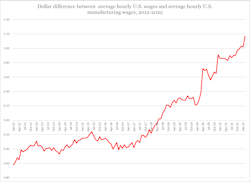Manufacturing Wages Lag US Average in Era of Amazon
A superficial reading of the numbers would suggest that manufacturers are having difficulty hiring people because, in a post-Amazon world where anyone in almost any state can make $15 an hour in one of the commerce giant’s omnipresent warehouses, wages simply aren’t keeping up. But a closer look at the numbers, their history and the makeup of the manufacturing sector show that there’s more to it than that.
It’s possible to work out at what points in the past few years have seen average manufacturing wages lag behind the total average. In recent years, non-manufacturing wages have grown at a higher rate than manufacturing wages. Average U.S. hourly wages surpassed average manufacturing wages in 2018—notably some months before Amazon announced its wage increases. And in early 2020, when COVID-19 first began to affect the world economy, the gap between wage growth in manufacturing and non-manufacturing grew even wider.
Two Classes of Manufacturing Jobs
Professor Michael Hicks, a professor of economics at Indiana’s Ball State University, notes that part of the situation is an increasing split in manufacturing jobs: not in durable goods and nondurable goods, as the Department of Labor has it, but high-wage jobs compatible with increasing automation and low-wage jobs too cheap to automate.
The sluggish growth of the average manufacturing wage? It isn’t stagnant wage growth across the board. It’s employment growth in the second, lower-paying category.
Over the past half-decade or so, Hicks says, manufacturing jobs have bifurcated into two categories, often clumsily described in terms of low- or high-skilled, as a result of how increased automation during the Great Recession carved out the middle earners in manufacturing.
“When a factory automates, there are two types of workers that remain,” Hicks says. “One, the people who are going to service the technology”—the kind of people with degrees and expertise in troubleshooting, quality control and industrial maintenance. The others keeping their jobs are those performing tasks that are just complicated enough that automation isn’t cost-effective.
If it’s true that manufacturing employment now more frequently sorts employees into one of these two groups—high-qualified workers receiving high wages, low-qualification workers receiving minimum wages—then the volatility of average manufacturing wages makes sense. As people who would have received mid-level wages—the middle of the curve between the highly skilled specialists and the low-skilled production people—make up a smaller portion of the manufacturing labor force, smaller changes in the outlying factions could be leading to more dramatic changes in average manufacturing wage growth—especially if the lower-wage group is growing faster.
Sign-On Bonuses Open the Door to Churn
In a time when manufacturers continue to report difficulty hiring and keeping employees, wages may be key to understanding one facet of the issue: Churn. National Association of Manufacturers economist Chad Moutray recently highlighted manufacturing churn indicated by recent Department of Labor figures after manufacturing quits hit 337,000—2.7% of the manufacturing workforce—in February.
In short, workers who know they can get a better deal for their wages elsewhere are not shy about packing up and leaving.
In Hick’s eyes, this is a failure of perspective from those in charge of hiring decisions. “I think a big portion of this is driven by pretty poor HR practices,” he says, specifically the use of sign-on bonuses as lures. The one-time checks turn into a perverse incentive for employees to job-hop:
"Particularly in logistics,” Hick says, manufacturers have mainly been able to get as many workers as they need since the Great Recession, which led them to one-time sign-on bonuses as a way to attract plentiful workers without hiking wages.
Heightened turnover is one potential consequence, Hicks continued. Workers with lots of choices of employer can stay at a business long enough to earn the sign-on bonus, then move on to the next one—especially if doing so would net them a higher base wage.
“What would stop that is an HR department that finally convinced their management and their finance team that they’re going to have to raise wages for everybody, otherwise, they’re just bearing that enormous turnover cost,” Hicks says.
In the Long Run
As automation splits manufacturing into high-wage experts and low-wage jobs, there’s little indication from the progress of industrial automation or from government wage figures that the trend will reverse; According to Statistica, the number of industrial robots in the world has doubled since 2014 to more than 3 million. That increasing automation will drive even more demand in manufacturing for engineers, who were already in short supply years before the current economy-wide worker shortage hit.
More strikingly, though, the above suggests that manufacturing is losing its biggest draw for low-wage workers—a stable career path to higher-than-average wages— at a time when it’s trying to hire more of those people than previously.
About the Author
Ryan Secard
Associate Editor
Ryan Secard joined Endeavor B2B in 2020 as a news editor for IndustryWeek. He currently contributes to IW, American Machinist, Foundry Management & Technology, and Plant Services on breaking manufacturing news, new products, plant openings and closures, and labor issues in manufacturing.

